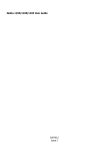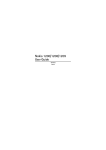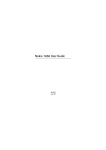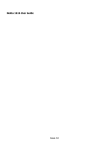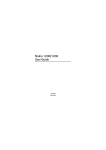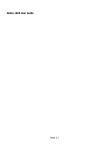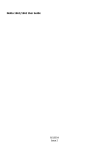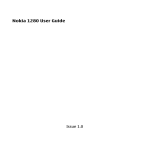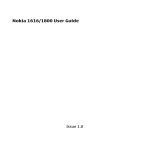Download Nokia 1280 1.36" 81.92g Blue
Transcript
Nokia 1280 User Guide Issue 2 2 Contents Contents Safety 3 Get started Insert the SIM card and battery Remove the SIM card Charge the battery Switch on and off 4 4 4 4 5 Your phone Keys and parts Main features Calls Write text Message Contacts Multi-phonebook FM Radio Flashlight shortcuts in standby mode 6 6 6 7 7 8 8 9 9 Product and safety information 9 10 Safety 3 Safety Read these simple guidelines. Not following them may be dangerous or illegal. Read the complete user guide for further information. SWITCH ON SAFELY Do not switch the device on when wireless phone use is prohibited or when it may cause interference or danger. ROAD SAFETY COMES FIRST Obey all local laws. Always keep your hands free to operate the vehicle while driving. Your first consideration while driving should be road safety. INTERFERENCE All wireless devices may be susceptible to interference, which could affect performance. SWITCH OFF IN RESTRICTED AREAS Follow any restrictions. Switch the device off in aircraft, near medical equipment, fuel, chemicals, or blasting areas. QUALIFIED SERVICE Only qualified personnel may install or repair this product. ACCESSORIES AND BATTERIES Use only approved accessories and batteries. Do not connect incompatible products. WATER-RESISTANCE Your device is not water-resistant. Keep it dry. 4 Get started Get started Insert the SIM card and battery This phone is intended for use with the BL-5CB battery. Safe removal. Always switch the device off and disconnect the charger before removing the battery. 1 2 3 4 Place your finger in the recess at the bottom of the device, and carefully lift and open the back cover (1). Lift the battery, and remove it (2). Insert the SIM card (3). Ensure the contact surface area is facing down and the bevelled corner of the SIM card is facing the bottom of the device. Replace the battery (4) and back cover (5, 6, 7). Remove the SIM card Press the release spring (1), and slide out the SIM card (2). Charge the battery Your battery has been partially charged at the factory. If the device indicates a low charge, do the following: 1 2 Connect the charger to a wall outlet. Connect the charger to the device. Get started 3 5 When the device indicates a full charge, disconnect the charger from the device, then from the wall outlet. Tip: To save energy, unplug the charger when the battery is fully charged. You do not need to charge the battery for a specific length of time, and you can use the device while it is charging. If the battery is completely discharged, it may take several minutes before the charging indicator appears on the display or before any calls can be made. Switch on and off Press and hold the end key. Use the phone only in its normal operating position. Your device may have internal and external antennas. Avoid touching the antenna area unnecessarily while the antenna is transmitting or receiving. Contact with antennas affects the communication quality and may cause a higher power level during operation and may reduce the battery life. 6 Your phone Your phone Keys and parts 1 Earpiece 2 Display 3 Selection keys 4 Navi™ key (scroll key) 5 Call key 6 End/Power key 7 Keypad 8 Headset connector (3.5mm) 9 Flashlight 10 Microphone 11 Wrist strap eyelet 12 Charger connector 13 Loudspeaker Main features Select Menu and from the following: Messages Create, send, and manage messages. Call register Access missed, received, and dialled calls. Contacts Save names and phone numbers. Your phone Settings Set up various features of your device. Radio Manage radio features. Games Play or set up the games in your device. SIM services Use supported SIM card services. Clock Set the time for the alarm. Reminders Manage reminders. Extras Access various applications. 7 Calls To make a call, enter the phone number, including the country code and area code, if necessary, and press the call key. To answer a call, press the call key. To end or reject a call, press the end key. To use a loudspeaker or earpiece during a call, select Loudsp. or Hands.. To adjust the volume during a call, scroll left or right. When the volume is high, do not hold the device near your ear. Write text To enter text, you can use traditional or predictive text input. Not all languages are supported by predictive text input. Use traditional text input Press a key repeatedly until the desired letter is displayed. Activate predictive text input Select Options > Dictionary and the desired language. Deactivate predictive text input Select Options > Dictionary > Dictionary off. When using predictive text input, press each key once for a single letter. If the desired word is displayed, press 0, and start writing the next word. If ? is displayed after the word, the word is not in the dictionary. Change a word Press * repeatedly until the desired word is displayed. Add a word Select Spell, enter the word using traditional text input, and select OK. 8 Your phone Add a space Press 0. Change text input method Press # repeatedly, and check the indicator at the top of the display. Add a number Press and hold the desired number key. Add a special character Press * when using traditional text input; press and hold * when using predictive text input. Undo clearing of a message Select Options > Undo clear. Message The message services can only be used if they are supported by your service provider. Your device supports text messages beyond the limit for a single message. Longer messages are sent as two or more messages. Your service provider may charge accordingly. Characters with accents, other marks, or some language options take more space, and limit the number of characters that can be sent in a single message. Write and send a message 1 Select Menu > Messages > Create message. 2 Write the message. The message length indicator shows how many characters you can enter in the message. 3 Select Options > Send, enter the recipient's phone number or select it from the contacts list, and select OK. Delete messages Select Menu > Messages > Delete messages > All read or the desired folder. Contacts You can save names and phone numbers in the phone and SIM card memory. The contacts list can contain up to 500 contacts, stored in the phone memory. Search for a contact Scroll down in the standby mode, enter the first characters or letters of the name, and scroll to the desired contact. Save contacts to the contacts list Select Menu > Contacts > Add contact. Your phone 9 Copy contacts between the phone and SIM card memory Select Menu > Contacts > Copy. Multi-phonebook Your phone supports up to five separate phonebooks for multiple users. When the multiphonebook is activated, only the contacts in the active phonebook are visible. A contact can belong to one or several phonebooks. The contacts in Shared cont. are accessible from all phonebooks. Select Menu > Contacts > Settings > Multi-Phonebook and the appropriate options. Activate the multi-phonebook Select Phonebook style > Multi-Phonebk.. Activate a phonebook Select Current phonebook and the desired phonebook or Shared cont.. Assign a contact to one or more phonebooks Select Manage contacts and the desired contact. Rename a phonebook Select Rename phonebooks and the desired phonebook. FM Radio The FM radio depends on an antenna other than the wireless device antenna. A compatible headset needs to be attached to the device for the FM radio to function properly. You may need to purchase a compatible headset separately. To open the radio, select Menu > Radio. To adjust the volume of the radio, scroll left or right. You need at least one saved channel for the clock radio to function properly. Warning: Continuous exposure to high volume may damage your hearing. Listen to music at a moderate level, and do not hold the device near your ear when the loudspeaker is in use. Flashlight shortcuts in standby mode To switch on, scroll up twice. To switch off, scroll up once. Do not shine the flashlight in anyone's eyes. 10 Product and safety information Product and safety information General information About your device The wireless device described in this guide is approved for use on the EGSM 900 and 1800 MHz networks. Contact your service provider for more information about networks. Warning: To use any features in this device, other than the alarm clock, the device must be switched on. Do not switch the device on when wireless device use may cause interference or danger. When using this device, obey all laws and respect local customs, privacy and legitimate rights of others, including copyrights. Copyright protection may prevent some images, music, and other content from being copied, modified, or transferred. Make back-up copies or keep a written record of all important information stored in your device. When connecting to any other device, read its user guide for detailed safety instructions. Do not connect incompatible products. The images in this guide may differ from your device display. Network services To use the device you must have service from a wireless service provider. Some features are not available on all networks; other features may require that you make specific arrangements with your service provider to use them. Network services involve transmission of data. Check with your service provider for details about fees in your home network and when roaming on other networks. Your service provider can explain what charges will apply. Your service provider may have requested that certain features be disabled or not activated in your device. If so, these features will not appear on your device menu. Your device may also have customized items such as menu names, menu order, and icons. Support When you want to learn more about how to use your product or you are unsure how your device should function, see the user guide or see the support pages at www.nokia.com/support or your local Nokia website, or with a mobile device, www.nokia.mobi/support. If this does not resolve your issue, do the following: • • Restart the device: switch off the device, and remove the battery. After about a minute, replace the battery, and switch on the device. Restore the original factory settings as explained in the user guide. If the issue remains unsolved, contact Nokia for repair options. See www.nokia.com/repair. Before sending your device for repair, always back up the data in your device. Accessories Warning: Use only batteries, chargers, and accessories approved by Nokia for use with this particular model. The use of any other types may invalidate any approval or warranty, and may be dangerous. In particular, use of unapproved chargers or batteries may present a risk of fire, explosion, leakage, or other hazard. For availability of approved accessories, please check with your dealer. When you disconnect the power cord of any accessory, grasp and pull the plug, not the cord. Product and safety information 11 Battery Battery and charger information Your device is powered by a rechargeable battery. The battery intended for use with this device is BL-5CB. Nokia may make additional battery models available for this device. This device is intended for use when supplied with power from the following chargers: AC-3. The exact charger model number may vary depending on the type of plug. The plug variant is identified by one of the following: E, EB, X, AR, U, A, C, K, or UB. The battery can be charged and discharged hundreds of times, but it will eventually wear out. When the talk and standby times are noticeably shorter than normal, replace the battery. Use only Nokia approved batteries, and recharge your battery only with Nokia approved chargers designated for this device. If a battery is being used for the first time or if the battery has not been used for a prolonged period, it may be necessary to connect the charger, then disconnect and reconnect it to begin charging the battery. If the battery is completely discharged, it may take several minutes before the charging indicator appears on the display or before any calls can be made. Safe removal. Always switch the device off and disconnect the charger before removing the battery. Proper charging. Unplug the charger from the electrical plug and the device when not in use. Do not leave a fully charged battery connected to a charger, since overcharging may shorten its lifetime. If left unused, a fully charged battery will lose its charge over time. Avoid extreme temperatures. Always try to keep the battery between 15°C and 25°C (59°F and 77°F). Extreme temperatures reduce the capacity and lifetime of the battery. A device with a hot or cold battery may not work temporarily. Battery performance is particularly limited in temperatures well below freezing. Do not short-circuit. Accidental short-circuiting can occur when a metallic object such as a coin, clip, or pen causes direct connection of the positive (+) and negative (-) terminals of the battery. (These look like metal strips on the battery.) This might happen, for example, when you carry a spare battery in your pocket or purse. Short-circuiting the terminals may damage the battery or the connecting object. Disposal. Do not dispose of batteries in a fire as they may explode. Dispose of batteries according to local regulations. Please recycle when possible. Do not dispose as household waste. Leak. Do not dismantle, cut, open, crush, bend, puncture, or shred cells or batteries. In the event of a battery leak, prevent battery liquid contact with skin or eyes. If this happens, flush the affected areas immediately with water, or seek medical help. Damage. Do not modify, remanufacture, attempt to insert foreign objects into the battery, or immerse or expose it to water or other liquids. Batteries may explode if damaged. Correct use. Use the battery only for its intended purpose. Improper battery use may result in a fire, explosion, or other hazard. If the device or battery is dropped, especially on a hard surface, and you believe the battery has been damaged, take it to a service centre for inspection before continuing to use it. Never use any charger or battery that is damaged. Keep your battery out of the reach of small children. Nokia battery authentication guidelines Always use original Nokia batteries for your safety. To check that you are getting an original Nokia battery, purchase it from a Nokia authorised service centre or dealer, and inspect the hologram label using the following steps: 12 Product and safety information Authenticate hologram 1 When you look at the hologram on the label, you should see the Nokia connecting hands symbol from one angle and the Nokia Original Enhancements logo when looking from another angle. 2 When you angle the hologram left, right, down and up, you should see 1, 2, 3 and 4 dots on each side respectively. Successful completion of the steps is not a total assurance of the authenticity of the battery. If you cannot confirm authenticity or if you have any reason to believe that your Nokia battery with the hologram on the label is not an authentic Nokia battery, you should refrain from using it, and take it to the nearest Nokia authorised service centre or dealer for assistance. To find out more about original Nokia batteries, see www.nokia.com/battery. Taking care of your device Your device is a product of superior design and craftsmanship and should be treated with care. The following suggestions will help you protect your warranty coverage. • • • • • • • • • • • Keep the device dry. Precipitation, humidity, and all types of liquids or moisture can contain minerals that will corrode electronic circuits. If your device does get wet, remove the battery, and allow the device to dry completely before replacing it. Do not use or store the device in dusty, dirty areas. Its moving parts and electronic components can be damaged. Do not store the device in high or cold temperature. High temperatures can shorten the life of electronic devices, damage batteries, and warp or melt certain plastics. When the device warms to its normal temperature from a cold temperature, moisture can form inside the device and damage electronic circuit boards. Do not attempt to open the device other than as instructed in this guide. Do not drop, knock, or shake the device. Rough handling can break internal circuit boards and fine mechanics. Do not use harsh chemicals, cleaning solvents, or strong detergents to clean the device. Only use a soft, clean, dry cloth to clean the surface of the device. Do not paint the device. Paint can clog the moving parts and prevent proper operation. Use only the supplied or an approved replacement antenna. Unauthorised antennas, modifications, or attachments could damage the device and may violate regulations governing radio devices. Use chargers indoors. Backup all data you want to keep, such as contacts and calendar notes. To reset the device from time to time for optimum performance, power off the device and remove the battery. Product and safety information 13 These suggestions apply equally to your device, battery, charger, or any accessory. Recycle Always return your used electronic products, batteries, and packaging materials to dedicated collection points. This way you help prevent uncontrolled waste disposal and promote the recycling of materials. Check product environmental information and how to recycle your Nokia products at www.nokia.com/werecycle, or nokia.mobi/werecycle. The crossed-out wheeled-bin symbol on your product, battery, literature, or packaging reminds you that all electrical and electronic products, batteries, and accumulators must be taken to separate collection at the end of their working life. This requirement applies in the European Union. Do not dispose of these products as unsorted municipal waste. For more environmental information, see the product Eco-Declarations at www.nokia.com/environment. Additional safety information The surface of this device is nickel-free. Small children Your device and its accessories are not toys. They may contain small parts. Keep them out of the reach of small children. Operating environment This device meets RF exposure guidelines in the normal use position at the ear or at least 1.5 centimetres (5/8 inch) away from the body. Any carry case, belt clip, or holder for body-worn operation should not contain metal and should position the device the above-stated distance from your body. To send data files or messages requires a quality connection to the network. Data files or messages may be delayed until such a connection is available. Follow the separation distance instructions until the transmission is completed. Parts of the device are magnetic. Metallic materials may be attracted to the device. Do not place credit cards or other magnetic storage media near the device, because information stored on them may be erased. Medical devices Operation of radio transmitting equipment, including wireless phones, may interfere with the function of inadequately protected medical devices. Consult a physician or the manufacturer of the medical device to determine whether they are adequately shielded from external RF energy. Switch off your device when regulations posted instruct you to do so. Hospitals or health care facilities may use equipment sensitive to external RF energy. Implanted medical devices Manufacturers of medical devices recommend a minimum separation of 15.3 centimetres (6 inches) between a wireless device and an implanted medical device, such as a pacemaker or implanted cardioverter defibrillator, to avoid potential interference with the medical device. Persons who have such devices should: • • • • • Always keep the wireless device more than 15.3 centimetres (6 inches) from the medical device. Not carry the wireless device in a breast pocket. Hold the wireless device to the ear opposite the medical device. Turn the wireless device off if there is any reason to suspect that interference is taking place. Follow the manufacturer directions for the implanted medical device. If you have any questions about using your wireless device with an implanted medical device, consult your health care provider. Hearing aids Some digital wireless devices may interfere with some hearing aids. 14 Product and safety information Vehicles RF signals may affect improperly installed or inadequately shielded electronic systems in motor vehicles such as electronic fuel injection, electronic antilock braking, electronic speed control, and air bag systems. For more information, check with the manufacturer of your vehicle or its equipment. Only qualified personnel should service the device or install the device in a vehicle. Faulty installation or service may be dangerous and may invalidate your warranty. Check regularly that all wireless device equipment in your vehicle is mounted and operating properly. Do not store or carry flammable liquids, gases, or explosive materials in the same compartment as the device, its parts, or accessories. Remember that air bags inflate with great force. Do not place your device or accessories in the air bag deployment area. Switch off your device before boarding an aircraft. The use of wireless teledevices in an aircraft may be dangerous to the operation of the aircraft and may be illegal. Potentially explosive environments Switch off your device in any area with a potentially explosive atmosphere. Obey all posted instructions. Sparks in such areas could cause an explosion or fire resulting in bodily injury or death. Switch off the device at refuelling points such as near gas pumps at service stations. Observe restrictions in fuel depots, storage, and distribution areas; chemical plants; or where blasting operations are in progress. Areas with a potentially explosive atmosphere are often, but not always, clearly marked. They include areas where you would be advised to turn off your vehicle engine, below deck on boats, chemical transfer or storage facilities and where the air contains chemicals or particles such as grain, dust, or metal powders. You should check with the manufacturers of vehicles using liquefied petroleum gas (such as propane or butane) to determine if this device can be safely used in their vicinity. Emergency calls Important: This device operates using radio signals, wireless networks, landline networks, and user-programmed functions. If your device supports voice calls over the internet (internet calls), activate both the internet calls and the cellular phone. The device may attempt to make emergency calls over both the cellular networks and through your internet call provider if both are activated. Connections in all conditions cannot be guaranteed. You should never rely solely on any wireless device for essential communications like medical emergencies. To make an emergency call: 1 If the device is not on, switch it on. Check for adequate signal strength. Depending on your device, you may also need to complete the following: • • • Insert a SIM card if your device uses one. Remove certain call restrictions you have activated in your device. Change your profile from Offline or Flight profile to an active profile. 2 Press the end key as many times as needed to clear the display and ready the device for calls. 4 Press the call key. 3 Enter the official emergency number for your present location. Emergency numbers vary by location. When making an emergency call, give all the necessary information as accurately as possible. Your wireless device may be the only means of communication at the scene of an accident. Do not end the call until given permission to do so. Certification information (SAR) This mobile device meets guidelines for exposure to radio waves. Your mobile device is a radio transmitter and receiver. It is designed not to exceed the limits for exposure to radio waves recommended by international guidelines. These guidelines were developed by the independent scientific organisation ICNIRP and include safety margins designed to assure the protection of all persons, regardless of age and health. The exposure guidelines for mobile devices employ a unit of measurement known as the Specific Absorption Rate or SAR. The SAR limit stated in the ICNIRP guidelines is 2.0 watts/kilogram (W/kg) averaged over 10 grams of tissue. Tests for SAR are conducted using standard operating positions with the device transmitting at its highest certified power level in all tested frequency bands. The actual SAR level of an operating device can be below the maximum value because the device is designed Product and safety information 15 to use only the power required to reach the network. That amount changes depending on a number of factors such as how close you are to a network base station. The highest SAR value under the ICNIRP guidelines for use of the device at the ear is 1.15 W/kg. Use of device accessories may result in different SAR values. SAR values may vary depending on national reporting and testing requirements and the network band. Additional SAR information may be provided under product information at www.nokia.com. 16 DECLARATION OF CONFORMITY Hereby, NOKIA CORPORATION declares that this RM-647 product is in compliance with the essential requirements and other relevant provisions of Directive 1999/5/EC. A copy of the Declaration of Conformity can be found at http:// www.nokia.com/phones/declaration_of_conformity/. © 2009 Nokia. All rights reserved. Nokia, Nokia Connecting People, and Navi are trademarks or registered trademarks of Nokia Corporation. Nokia tune is a sound mark of Nokia Corporation. Other product and company names mentioned herein may be trademarks or tradenames of their respective owners. Reproduction, transfer, distribution, or storage of part or all of the contents in this document in any form without the prior written permission of Nokia is prohibited. Nokia operates a policy of continuous development. Nokia reserves the right to make changes and improvements to any of the products described in this document without prior notice. TO THE MAXIMUM EXTENT PERMITTED BY APPLICABLE LAW, UNDER NO CIRCUMSTANCES SHALL NOKIA OR ANY OF ITS LICENSORS BE RESPONSIBLE FOR ANY LOSS OF DATA OR INCOME OR ANY SPECIAL, INCIDENTAL, CONSEQUENTIAL OR INDIRECT DAMAGES HOWSOEVER CAUSED. THE CONTENTS OF THIS DOCUMENT ARE PROVIDED "AS IS". EXCEPT AS REQUIRED BY APPLICABLE LAW, NO WARRANTIES OF ANY KIND, EITHER EXPRESS OR IMPLIED, INCLUDING, BUT NOT LIMITED TO, THE IMPLIED WARRANTIES OF MERCHANTABILITY AND FITNESS FOR A PARTICULAR PURPOSE, ARE MADE IN RELATION TO THE ACCURACY, RELIABILITY OR CONTENTS OF THIS DOCUMENT. NOKIA RESERVES THE RIGHT TO REVISE THIS DOCUMENT OR WITHDRAW IT AT ANY TIME WITHOUT PRIOR NOTICE. The availability of particular products and applications and services for these products may vary by region. Please check with your Nokia dealer for details and availability of language options. This device may contain commodities, technology or software subject to export laws and regulations from the US and other countries. Diversion contrary to law is prohibited. /Issue 2 EN

















